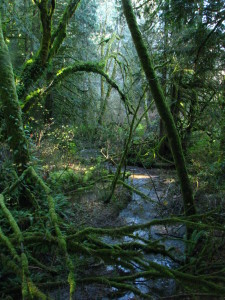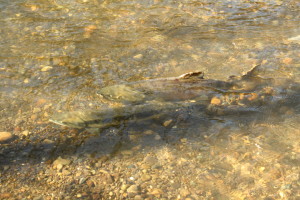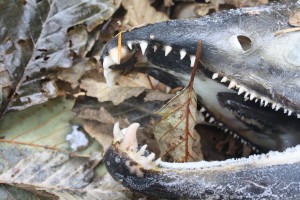 My very first day of work at SPSSEG was Docent training day out at Kennedy Creek Salmon Trail. Although I have worked in one way or another in the salmon recovery field on and off for the last three years, I was enraptured as Lance described spawning behavior, a critical facet of salmon biology that I had yet to learn much about. And suddenly as I walked the trail and watched the fish in the creeks, I was filled with stark clarity – now I was privy to a secret salmon language.
My very first day of work at SPSSEG was Docent training day out at Kennedy Creek Salmon Trail. Although I have worked in one way or another in the salmon recovery field on and off for the last three years, I was enraptured as Lance described spawning behavior, a critical facet of salmon biology that I had yet to learn much about. And suddenly as I walked the trail and watched the fish in the creeks, I was filled with stark clarity – now I was privy to a secret salmon language.
As I watched, every splash laden with new meaning, a goal developed quickly in the back of my mind. What if I could somehow capture these behaviors, and share them at docent training? What if I could share them with the WHOLE WORLD? Because there isn’t much I love more than sharing knowledge.
So I embarked wholeheartedly on the journey to capture salmon courtship. I egged on combative gentlemen salmon and redd digging salmon ladies. And now, I have something magical to share.
First I made a little video of Kennedy Creek Salmon Trail’s 2014 season. We had 2,300 students and close to 3,000 weekend visitors, facilitated by that amazing group of volunteer Docents I met on my first day of work. Its an understatement to say that we could not run this program without them.
Then I began compiling a behavior video. But first, in case you don’t yet know, here’s a few tricks that will help you to…
Distinguish chum salmon males vs. a females:

Males are typically larger with a slight hump, vertical ‘tiger’ stripes, large hooked noses, and jaws filled with large teeth – from which the moniker dog salmon was derived.
Females are generally smaller and streamlined, with a dark horizontal ‘racing stripe’ down the lateral line.

Without further ado…
The following is a work in progress, suggestions are welcome!
What does it all mean?
Male vs. Male: Males will fight to assert dominance, as in many other species. The dominant male will fend off others so he has the very best chance of fertilizing as many eggs as possible
Nosing, test digging: Females will essentially ‘smell’ for areas with upwelling water to place their redds, and test it out. Upwelling water ensures a flow of oxygenated water to the eggs and alevin in the redd.
Quivering: This behavior serves a sort of nudging along, encouraging the female to dig and ultimately release eggs. Quivering impacts the sensitive cells on the female’s lateral line, stimulating action from the female.
Crossover: Dominant males swim back and forth over a female’s back to watch for encroaching males
Digging: There are several forms of digging – the test dig, excavation dig, and digging to cover eggs.
The main thing I have learned thus far is that there is always more to learn!
-Phoebe

pete bunting
I have watched the salmon runs in McCall, Idaho, Taylor Creek at Lake Tahoe, and on the Sacramento river. They could learn something on educating the public from this educational presentation.
Elaine
Good job Phoebe. I love salmon, especially smoked. I used to take my students to LaGrange each Nov. to observe the spawning Chinook. Only a couple hundred on the Tuolumne, likely to become extinct some day. Not much water/snow in the Sierra yet this winter. E